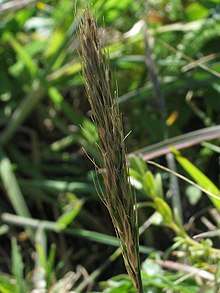Trisetum canescens
Trisetum canescens is a species of grass known by the common names tall trisetum[1] and tall false oat.
| Trisetum canescens | |
|---|---|
 | |
| Scientific classification | |
| Kingdom: | Plantae |
| Clade: | Tracheophytes |
| Clade: | Angiosperms |
| Clade: | Monocots |
| Clade: | Commelinids |
| Order: | Poales |
| Family: | Poaceae |
| Subfamily: | Pooideae |
| Genus: | Trisetum |
| Species: | T. canescens |
| Binomial name | |
| Trisetum canescens Buckley | |
The bunchgrass is native to western North America from Alaska and British Columbia to central California and Arizona, where it occurs in forests, mountain meadows, and streambanks, being most common among Ponderosa pines and stands of spruce and fir.
Description
Trisetum canescens is a perennial bunchgrass forming clumps of erect stems up to 50–80 centimetres (20–31 in) tall, but known to exceed 1 metre (3.3 ft).
There are three to four leaves per stem, the blades reaching up to 30 centimeters in length. The sheaths can be hairless to quite hairy, the hairs sometimes long and shaggy.
The inflorescence is an open or compact panicle of green, tan, or purplish spikelets up to 20 centimeters long.
References
- "Trisetum canescens". Natural Resources Conservation Service PLANTS Database. USDA. Retrieved 15 December 2015.
External links
- Jepson Manual Treatment: Trisetum canescens
- Grass Manual Treatment — Trisetum canescens
- Trisetum canescens — U.C. Photo gallery